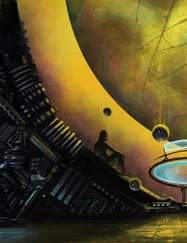The Bicamerals set out to damage their brains, in very specific ways. They manipulated the expression of NR2B, [67] Deheng Wang et al., “Genetic Enhancement of Memory and Long-Term Potentiation but Not CA1 Long-Term Depression in NR2B Transgenic Rats,” PLoS ONE 4, no. 10 (October 19, 2009): e7486, doi:10.1371/journal.pone.0007486.
tweaked TRNP-1 [68] Ronny Stahl et al., “Trnp1 Regulates Expansion and Folding of the Mammalian Cerebral Cortex by Control of Radial Glial Fate,” Cell 153, no. 3 (April 25, 2013): 535–549, doi:10.1016/j.cell.2013.03.027.
production, used careful cancers to promote growth (their genes tagged for easy identification, [69] Robert M. Hoffman, “The Multiple Uses of Fluorescent Proteins to Visualize Cancer in Vivo,” Nature Reviews. Cancer 5, no. 10 (October 2005): 796–806, doi:10.1038/nrc1717.
should anything go wrong) and increase neurosculptural degrees of freedom. Then they ruthlessly weeded those connections, pruned back the tangle into optimum, isolated islands of functionality. [70] Anonymous, “Autism: Making the Connection,” The Economist , August 5, 2004, http://www.economist.com/node/3061282 .
They improved their pattern-matching skills to a degree almost inconceivable to mere baselines.
Such enhancements come at a cost. [71] Fabienne Samson et al., “Enhanced Visual Functioning in Autism: An ALE Meta-analysis,” Human Brain Mapping 33, no. 7 (2012): 1553–1581, doi:10.1002/hbm.21307.
, [72] Deborah Halber, “Gene Research May Help Explain Autistic Savants - MIT News Office,” MIT’s News Office , 2008, http://web.mit.edu/newsoffice/2008/savants-0212.html .
Bicamerals have lost the ability to communicate effectively across the cognitive-species divide. It’s not just that they’ve rewired their speech centers. [73] Fumiko Hoeft et al., “Functional and Morphometric Brain Dissociation Between Dyslexia and Reading Ability,” Proceedings of the National Academy of Sciences 104, no. 10 (March 6, 2007): 4234–4239, doi:10.1073/pnas.0609399104.
and are now using different parts of the brain to talk; they think now almost entirely in metaphor, in patterns that contain meaning even if they don’t, strictly speaking, exist.
Things get even messier when linked into networks, which can literally scatter one’s mind even at today’s rudimentary levels of connectivity. The “transactive memory system” called Google is already rewiring the parts of our brains that used to remember facts locally; now, those circuits store search protocols for remote access of a distributed database. [74] B. Sparrow, J. Liu, and D. M. Wegner, “Google Effects on Memory: Cognitive Consequences of Having Information at Our Fingertips,” Science 333, no. 6043 (July 14, 2011): 776–778, doi:10.1126/science.1207745.
And Google doesn’t come anywhere close to the connectivity of a real hive mind.
Which is not to say that hive minds aren’t already a ubiquitous part Human society. You are a hive mind, always have been: a single coherent consciousness spread across two cerebral hemispheres, each of which—when isolated—can run its own stand-alone, conscious entity with its own thoughts, aesthetics, even religious beliefs. [75] V. S. Ramachandran and Stuart Hameroff, “Beyond Belief: Science, Reason, Religion & Survival. Salk Institute for Biological Studies, Nov 5–7, 2006 (Session 4),” The Science Network , 2006, http://thesciencenetwork.org/programs/beyond-belief-science-religion-reason-and-survival/session-4-1 .
The reverse also happens. A hemisphere forced to run solo when its partner is anaesthetised (preparatory to surgery, for instance) will manifest a different personality than the brain as a whole—but when those two hemispheres reconnect, that solo identity gets swallowed up by whatever dual-core persona runs on the whole organ. [16] Vilayanur S. Ramachandran and Sandra Blakeslee, Phantoms in the Brain (New York: Quill, 1999).
Consciousness expands to fill the space available.
The Bicameral hive takes its lead from Krista and Tatiana Hogan, conjoined craniopagus twins whose brains are fused at the thalamus. [76] Jordan Squair, “Craniopagus: Overview and the Implications of Sharing a Brain,” University of British Columbia’s Undergraduate Journal of Psychology (UBCUJP) 1, no. 0 (May 1, 2012), http://ojs.library.ubc.ca/index.php/ubcujp/article/view/2521 .
Among other things, the thalamus acts as a sensory relay; the twins share a common set of sensory inputs. Each sees through the other’s eyes. Tickle one, the other laughs. Anecdotal evidence suggests that they can share thoughts, and although they have distinct personalities each uses the word “I” when talking about the other twin.
All this resulting from fusion at a sensory relay. Suppose they were linked further up? A thought doesn’t know to stop and turn back when it reaches the corpus callosum. Why would it behave any differently if it encountered a callosum of a different sort, why should two minds linked by a sufficiently fat pipe be any more distinct than the halves of your own brain?
Sufficiently high bandwidth, therefore, would likely result in a single integrated consciousness across any number of platforms. Technologically, the links themselves might exploit so-called “ephatic coupling” [77] Costas A. Anastassiou et al., “Ephaptic Coupling of Cortical Neurons,” Nature Neuroscience 14, no. 2 (February 2011): 217–223, doi:10.1038/nn.2727.
(in which direct synaptic stimulation is bypassed and neurons are induced to fire by diffuse electrical fields generated elsewhere in the brain). Synchrony is vital: unified conscious only exists when all parts fire together with a signal latency of a few hundred milliseconds, tops. [23] Giulio Tononi and Gerald M. Edelman, “Consciousness and Complexity,” Science 282, no. 5395 (December 4, 1998): 1846–1851, doi:10.1126/science.282.5395.1846.
, [24] Jaakko W. Långsjö et al., “Returning from Oblivion: Imaging the Neural Core of Consciousness,” The Journal of Neuroscience 32, no. 14 (April 4, 2012): 4935–4943, doi:10.1523/JNEUROSCI.4962-11.2012.
Throttle that pipe and it should be possible to retain individuality while accessing memories and sensory data from your fellow nodes. [78] Kaj Sotala and Harri Valpola, “Coalescing Minds: Brain Uploading-Related Group Mind Scenarios,” International Journal of Machine Consciousness 04, no. 01 (June 2012): 293–312, doi:10.1142/S1793843012400173.
I’ve kept the extent of Bicameral hive integration flexible, allowing internode connections to throttle up and down as the need arises—but whether those bandwidth- vs. -dialup decisions are made by the nodes themselves or by something more inclusive remains ambiguous. If you want some hint of the ramifications of total cognitive integration, I point you to the (apparently) catatonic Moksha Mind of the Dharmic Alliance. [79] The Pontifical Academy of Sciences, “An Enemy Within: The Bicameral Threat to Institutional Religion in the Twenty-First Century (An Internal Report to the Holy See)” (Internal Report., 2093).
However the hive links up—whatever its degree of conscious coherence—it is a religious experience. Literally.
We know what rapture is: a glorious malfunction, a glitch in the part of the brain that keeps track of where the body ends and everything else begins. [80] A. B. Newberg and E.G. d’ Aquili, “The Neuropsychology of Religious and Spiritual Experience,” Journal of Consciousness Studies 7, no. 11–12 (November 1, 2000): 251–266.
When that boundary dissolves the mind feels connected to everything, feels literally at one with the universe. It’s an illusion, of course. Transcendence is experience, not insight. That’s not why Bicamerals feel the rapture.
Читать дальше








